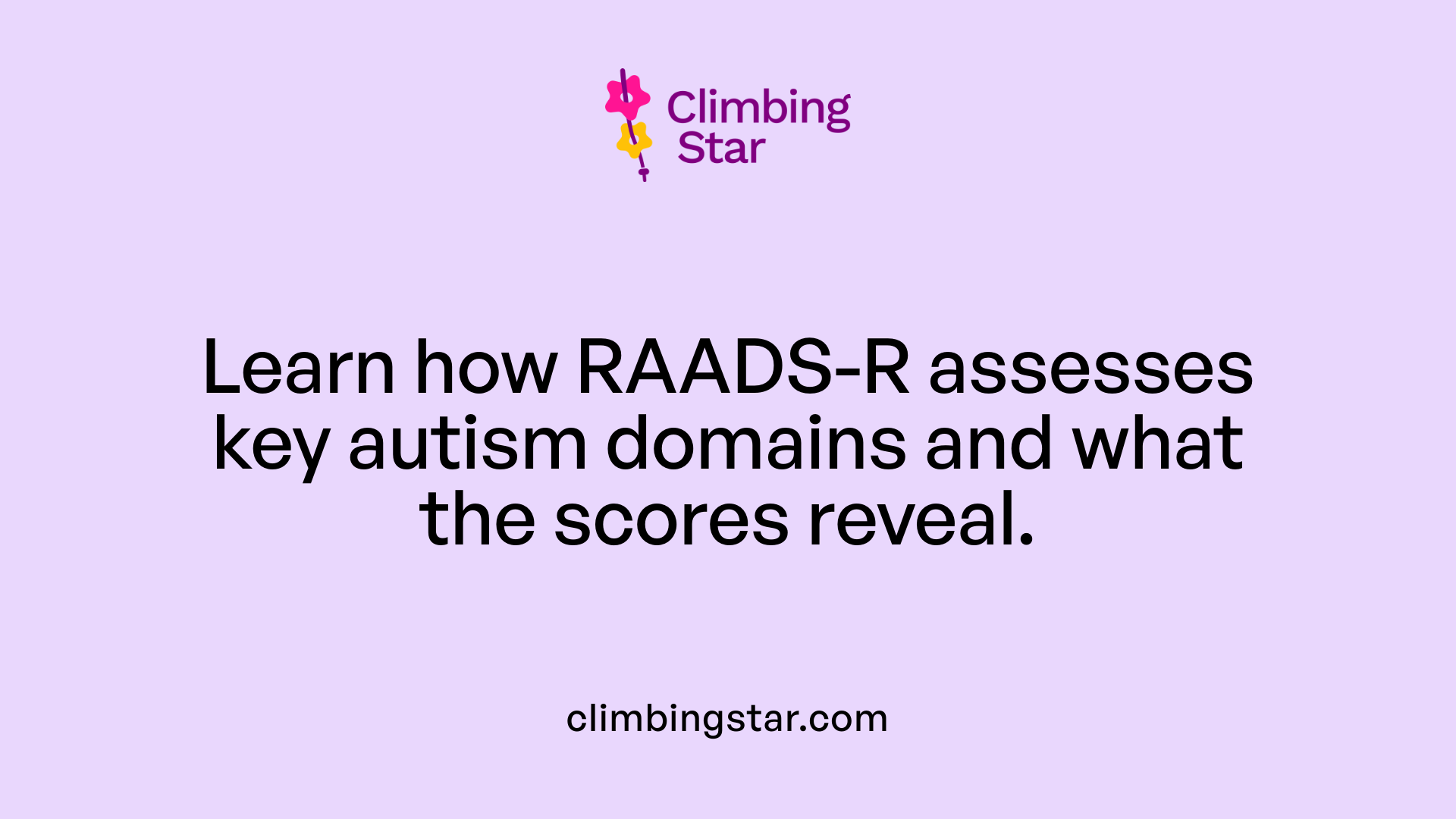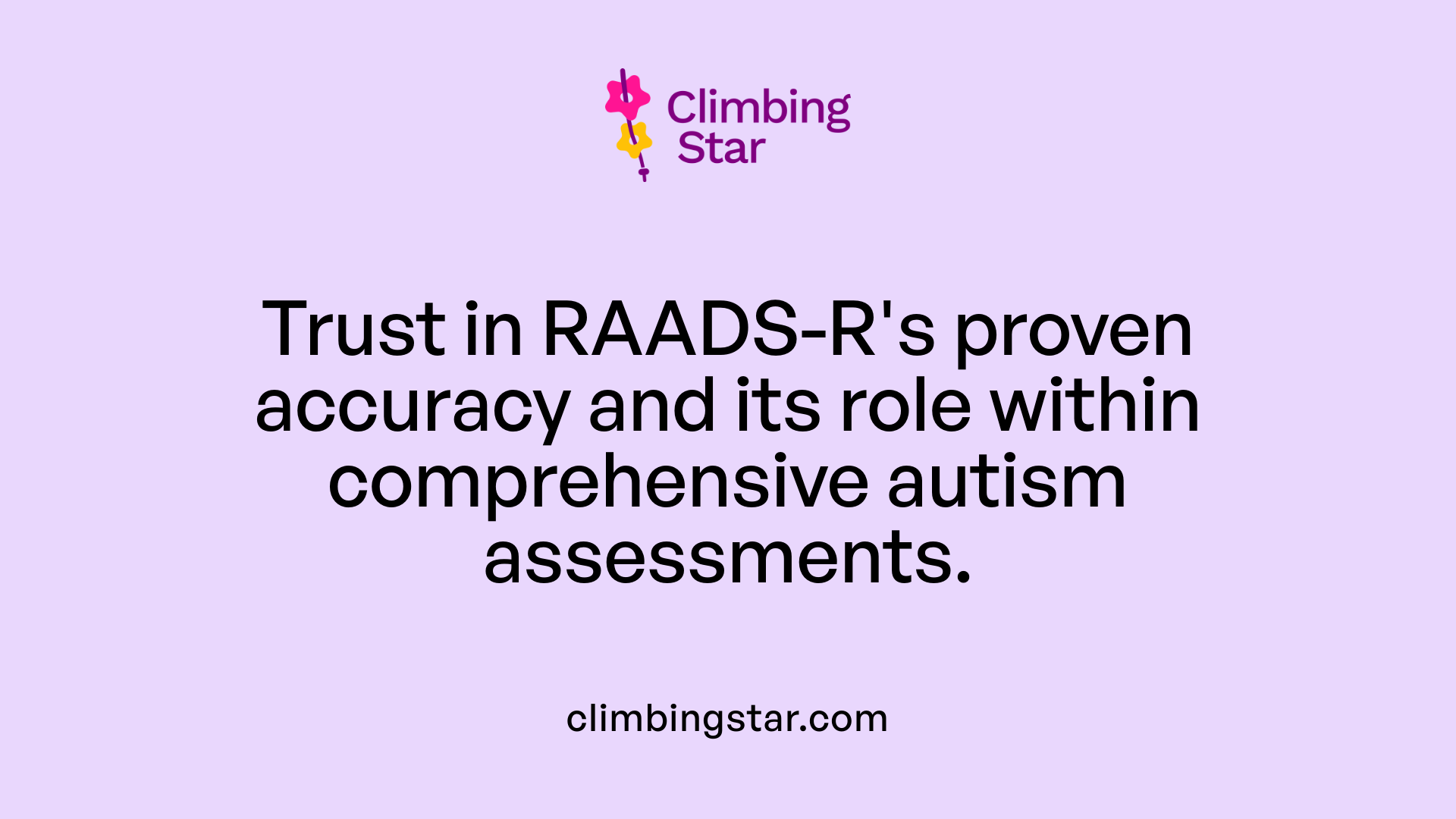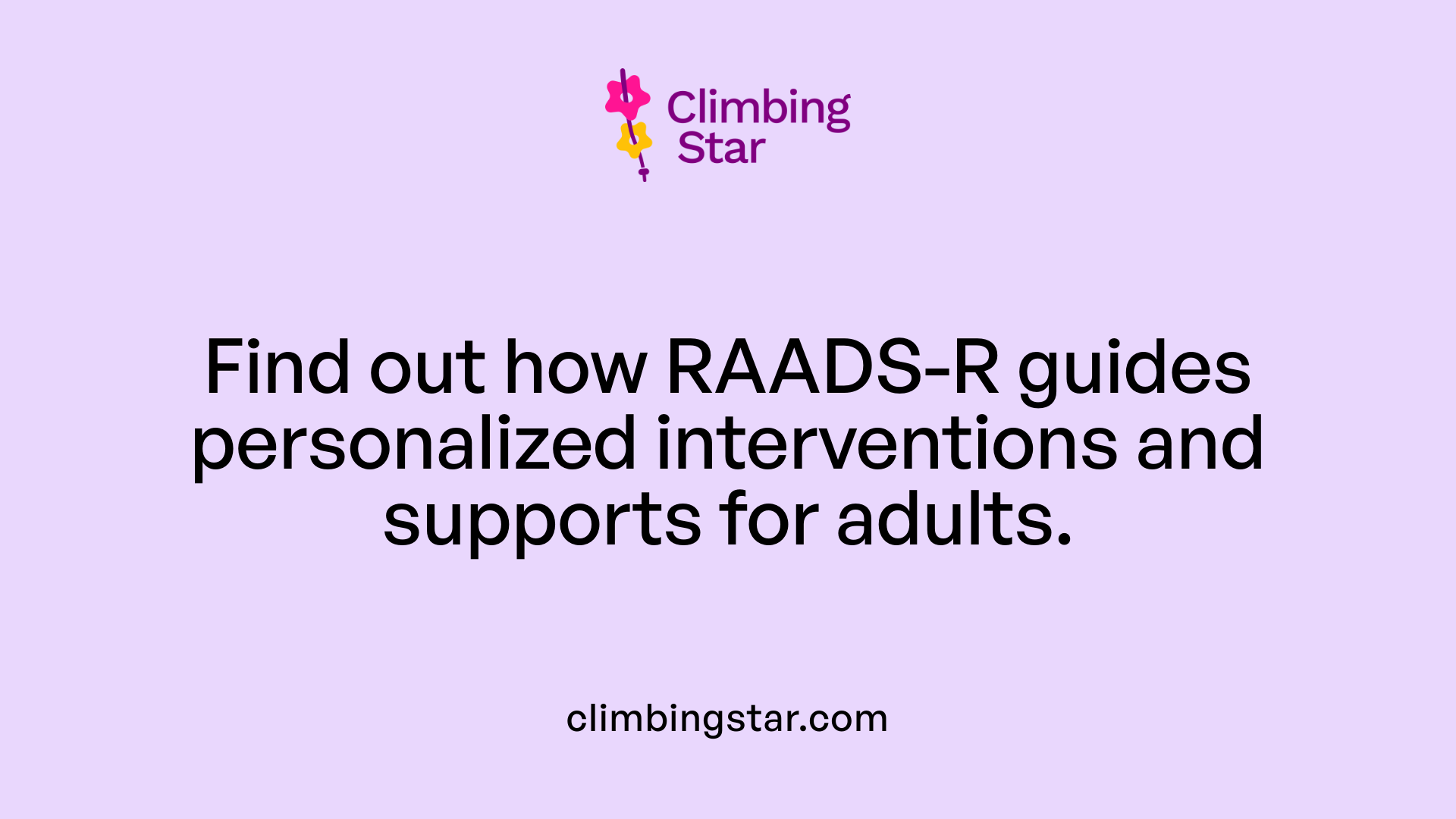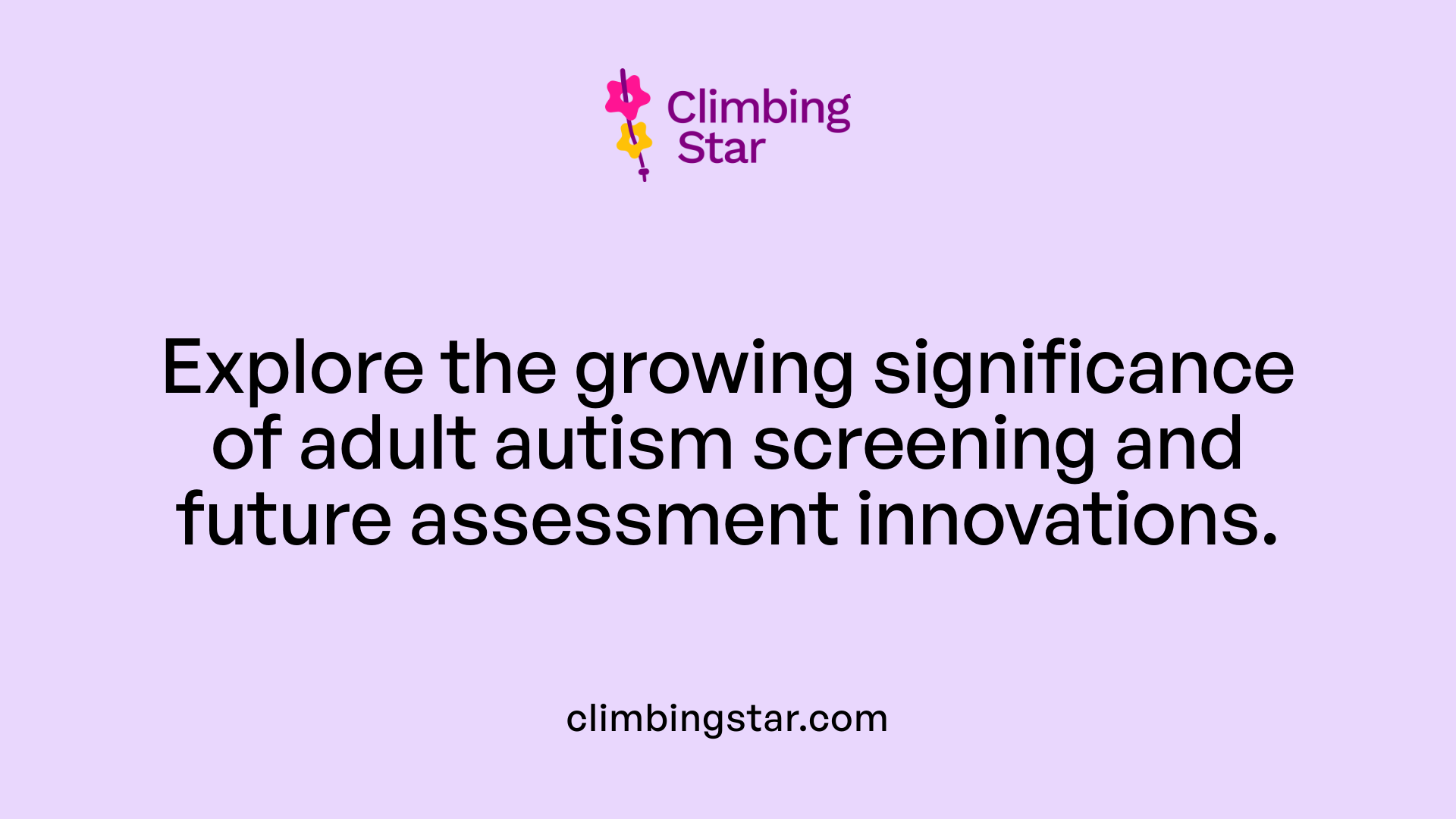Introduction to Adult Autism Assessment
Autism spectrum disorder (ASD) presents unique challenges for adults who may have remained undiagnosed in childhood. The RAADS-R test has emerged as a crucial tool in identifying adult autism, especially for those with subtler presentations. This article explores the RAADS-R test, what it measures, its significance in clinical settings, and its place within comprehensive autism evaluation and support frameworks.
What is the RAADS-R Test?

Definition and Purpose of RAADS-R
The RAADS-R, or Ritvo Autism Asperger Diagnostic Scale–Revised, is a self-report questionnaire developed for identifying autism spectrum traits in adults. It is specifically designed to evaluate individuals aged 16 and older for level 1 autism spectrum disorder (ASD), often covering those whose autism has gone unnoticed or undiagnosed earlier in life because their symptoms may be subtle or atypical. The test helps clinicians and individuals better understand neurodiversity and guides further assessments rather than providing a diagnosis alone.
Self-Report Nature of the Test
The RAADS-R consists of 80 questions that respondents answer themselves, typically in a clinical setting with a qualified professional's guidance. This self-assessment approach allows individuals to share insights into their personal experiences across key areas such as social communication, sensory processing, and repetitive behaviors, which might not be fully observable by others. The test usually takes around 15 to 20 minutes to complete and requires honest, reflective responses for accurate results.
Population Targeted by RAADS-R
This tool is aimed at adults, particularly those over 16 years old, who have suspected or diagnosed level 1 autism without intellectual disability. It fills an important gap in autism assessment by focusing on late-diagnosed or covert cases where conventional childhood-based diagnostic tools are less effective. The RAADS-R serves as one part of a comprehensive evaluation process to support clinical decision-making and individualized care planning.
How Does the RAADS-R Test Work?

What areas does the RAADS-R assess and how is it structured?
The RAADS-R test is a self-report questionnaire designed specifically for adults to evaluate traits associated with level 1 autism spectrum disorder (ASD). It consists of 80 questions that explore four main areas: social relatedness, language and communication, sensory-motor function, and circumscribed or restricted interests. These domains reflect core autism traits such as challenges in social interaction, communication difficulties, sensitivity to sensory input, and focused or repetitive behaviors.
Number of questions and scoring system
Each of the 80 questions contributes to an overall score, which can range from 0 to 240 points. A score of 65 or higher suggests a significant likelihood of autism, indicating the presence of autistic traits. Higher scores typically correspond to a greater intensity of these traits. However, it is important to note that the RAADS-R is a screening tool and should not be used alone for diagnosis; professional evaluation is essential.
Time to complete the test
The RAADS-R is designed to be efficient, typically taking between 15 to 20 minutes to complete. It is commonly self-administered under the supervision or guidance of a qualified clinician, ensuring an accurate and reliable completion process. This quick turnaround is important for making the tool practical in clinical settings and for individuals seeking to better understand their neurodiversity.
Reliability and Clinical Utility of the RAADS-R

How reliable and effective is the RAADS-R test?
The RAADS-R (Ritvo Autism Asperger Diagnostic Scale–Revised) is recognized globally for its reliability and clinical effectiveness. Research supports its accuracy with remarkable statistics: it demonstrates a specificity of 100%, meaning it correctly identifies those without autism, and a sensitivity of 97%, accurately detecting individuals with autistic traits. These figures highlight the RAADS-R as a dependable screening tool capable of distinguishing autism-related behaviors in adults.
What role do clinicians play in administering and interpreting the RAADS-R?
Despite its strengths, the RAADS-R is not a standalone diagnostic tool. It is typically self-administered but conducted under the supervision of qualified clinicians who guide individuals through the questionnaire and interpret the results. Professionals integrate RAADS-R scores with clinical evaluations, developmental history, and other diagnostic instruments to form a comprehensive assessment.
This multidisciplinary approach ensures that RAADS-R findings are meaningfully contextualized, improving diagnostic accuracy and guiding appropriate interventions and support. Clinicians’ expertise is essential for interpreting scores—where results of 65 or higher suggest a likelihood of autism but require further professional evaluation.
Why is the RAADS-R important in adult autism assessment?
The RAADS-R fills an important gap by focusing on adults, particularly those who may have remained undiagnosed or misdiagnosed in earlier years. Its scientific validation, combined with professional oversight, supports more accurate identification of autism spectrum traits, offering individuals a greater understanding of their neurodiversity and access to tailored support.
| Aspect | Detail | Importance |
|---|---|---|
| Specificity | 100% | Confirms accuracy in identifying non-autistic individuals |
| Sensitivity | 97% | Strong ability to detect autistic traits |
| Number of Questions | 80 | Covers broad autism-related symptom areas |
| Clinical interpretation | Required | Ensures comprehensive, accurate diagnosis |
| Intended Use | Screening tool, not standalone diagnosis | Supports but does not replace full clinical evaluation |
The RAADS-R in Comprehensive Autism Diagnosis
Is the RAADS-R used alone to diagnose autism?
No, the RAADS-R is not a standalone diagnostic tool. It serves as a screening questionnaire that helps identify autism spectrum traits in adults, especially those with level 1 autism. However, for an official diagnosis, it must be part of a broader assessment process.
The test as part of a holistic assessment
The RAADS-R contributes valuable insights by assessing symptoms across four domains: social relatedness, language, sensory-motor function, and circumscribed interests. Its 80-item self-report questionnaire complements other diagnostic tools by capturing self-perceived challenges and behaviors. Since it relies on honest responses from adults, it provides a perspective that clinical observation alone might miss.
Complementary tools and evaluations
To ensure a thorough evaluation, clinicians use the RAADS-R alongside other assessments such as detailed clinical interviews, developmental histories, and observational tools like the ADOS-2. Input from family members or caregivers can also enrich the understanding of an individual's autistic traits. This multi-method approach helps clarify the presence, severity, and impact of symptoms.
Importance of professional guidance
Professional interpretation is critical when using RAADS-R results. Trained healthcare providers integrate the scores with clinical observations and history to form an accurate diagnosis. This ensures that any diagnosis reflects a comprehensive view of the individual’s functioning and informs tailored support and intervention plans.
Using the RAADS-R within a comprehensive diagnostic framework increases confidence in identifying autism accurately and supports adults in accessing appropriate care, understanding their neurodiversity, and making informed decisions about their lives.
Interpreting RAADS-R Scores and Their Implications
Score thresholds and what they mean
The RAADS-R test yields scores from 0 to 240, with 65 set as the critical threshold. A score at or above 65 indicates a high likelihood of autism spectrum traits, signaling that an individual may benefit from further assessment by a clinician. Scores below 65 typically suggest fewer autistic traits but do not rule out autism completely without additional evaluation.
Relationship between scores and autistic traits
Higher RAADS-R scores correlate with more pronounced behaviors and symptoms consistent with autism. These include challenges in social relatedness, language and communication difficulties, sensory sensitivities, and restricted or circumscribed interests. This relationship makes the RAADS-R a valuable screening tool, helping to highlight individuals who may have been previously undiagnosed or whose autism presents more subtly.
Limitations of score interpretation
While RAADS-R scores provide useful insight, they are not diagnostic on their own. The test relies on self-reporting and must be administered and interpreted by qualified health professionals within the context of a comprehensive clinical evaluation. Scores should be combined with clinical interviews, observational assessments, developmental history, and additional tools to ensure an accurate diagnosis and personalized support planning.
Benefits of RAADS-R Testing for Adults
How can RAADS-R testing benefit adults with suspected autism?
The RAADS-R test plays a vital role in helping adults understand their neurodiversity by identifying traits associated with autism spectrum disorder that may have been previously undetected. By providing insights into behaviors related to social interactions, communication, sensory sensitivities, and interests, adults can gain a clearer picture of their unique neurological profile.
Helping adults understand neurodiversity
Many adults undergoing the RAADS-R test discover how their experiences and behaviors align with autism spectrum traits. This self-awareness fosters acceptance and empowers individuals to embrace their differences positively. The self-reporting nature of the questionnaire allows insights that might be missed through observation alone, especially in subtle or "covert" autism presentations.
Accessing appropriate support services
A score above the threshold on the RAADS-R indicates a likelihood of autism, which can act as a starting point for seeking clinical evaluations and accessing targeted support services. Understanding one's neurodiversity enables adults to pursue tailored interventions, resources, and accommodations that improve daily functioning and quality of life.
Improving self-awareness and personal development
Beyond diagnosis, RAADS-R results help individuals explore personal strengths and challenges linked to autism traits. This knowledge aids in developing coping strategies, improving relationships, making informed career choices, and enhancing educational planning. The test supports ongoing personal growth by highlighting specific areas needing attention or support.
Overall, the RAADS-R test guides adults toward greater clarity about their neurological identity, fostering improved well-being and empowering informed decisions about support and self-development.
The Role of Self-Reporting in RAADS-R
Why does the RAADS-R use self-reporting, and what are its implications?
The RAADS-R test relies heavily on self-reporting to gain a deeper understanding of an individual's unique experiences with autism, particularly in adults who may have more subtle or hidden symptoms. Self-assessment allows individuals to express personal insights into their social interactions, sensory experiences, and circumscribed interests that might not be easily observed by others.
Importance of self-reporting for subtle symptom detection
Many adults with autism have learned to mask or adapt behaviors, making external observation alone insufficient. Self-reporting captures these nuanced symptoms and internal experiences, enabling a more accurate reflection of traits that could otherwise go unnoticed.
Advantages and challenges of self-assessment
Self-reporting empowers individuals to actively participate in their assessment, providing a voice in their diagnosis and understanding of neurodiversity. However, it depends heavily on honest and thoughtful responses, which can be influenced by self-awareness and willingness to disclose. Misinterpretations or incomplete answers could affect results.
Why professional oversight is necessary
While the RAADS-R is a valuable screening tool, professional guidance is essential to interpret results accurately. Clinicians consider the self-reported data alongside clinical observations, developmental history, and other assessments to build a comprehensive diagnostic picture. This oversight ensures that results are valid and that individuals receive appropriate support and intervention plans tailored to their needs.
Applying RAADS-R Results to Support and Therapy

Using test outcomes to plan interventions
The RAADS-R test provides valuable insights into an individual's specific traits and challenges related to autism. By pinpointing areas such as social relatedness, language, sensory-motor function, and restricted interests, clinicians can tailor interventions that directly address these domains. This personalized understanding ensures that support strategies are aligned with each person's unique needs, enhancing their effectiveness.
Connection to therapies like Applied Behavior Analysis (ABA)
Applied Behavior Analysis (ABA) therapy is a scientifically supported approach focusing on improving beneficial behaviors and minimizing harmful ones by leveraging principles such as positive reinforcement. ABA is highly adaptable, involving individualized treatment plans that often concentrate on communication, social skills, self-care, and academic performance. RAADS-R scores help delineate which areas require focused attention, enabling practitioners to refine ABA strategies to better support the individual's developmental goals.
Role in shaping individualized treatment plans
The rich data from RAADS-R assessments contribute to comprehensive treatment planning, forming a foundation upon which professionals can build targeted therapies. By combining RAADS-R insights with other clinical evaluations, healthcare providers can construct individualized plans that address both strengths and challenges. This collaborative approach helps optimize therapeutic outcomes and supports meaningful progress in daily functioning and quality of life for adults with autism.
Future Directions and Importance of Adult Autism Assessment

Why is the RAADS-R particularly important for adult autism diagnosis?
Many autism assessments primarily focus on children and adolescents, which means adults often face challenges in getting a timely and accurate diagnosis. The RAADS-R addresses this diagnostic gap by offering a scientifically validated, self-report questionnaire specifically designed for adults. It enables identification of autism traits that may have gone undetected, especially in individuals diagnosed later in life.
Filling diagnostic gaps for adults
The RAADS-R fills a crucial role by supporting diagnosis in adults over 16 years old who suspect they might be on the autism spectrum but have not had earlier evaluations. Since adult neurodivergent individuals often present differently than children, this tool helps clinicians assess traits through four dimensions: language and communication, social relatedness, sensory-motor functions, and circumscribed interests.
Importance of early and accurate identification
Accurate identification of autism in adulthood can lead to better tailored support services, improved understanding of neurodiversity, and enhanced personal and professional outcomes. Early recognition, even in later life, can support improved relationships, career decisions, and mental health by guiding interventions suited to the individual's needs.
Ongoing developments in assessment tools
While the RAADS-R is a reliable and validated screening instrument with high sensitivity and specificity, it is designed as a part of a comprehensive assessment rather than a standalone diagnostic tool. Ongoing research and tool development continue to refine adult autism evaluation, combining self-report tools with clinical interviews and observational assessments to enhance accuracy and effectiveness.
This evolving approach ensures adults receive a thorough and compassionate diagnostic process, leading to better support and acceptance within communities.
| Aspect | Description | Importance |
|---|---|---|
| Target Population | Adults 16+ with suspected or diagnosed level 1 autism without intellectual disability | Addresses underdiagnosis in adults |
| Assessment Domains | Language, social relatedness, sensory-motor, circumscribed interests | Covers core autism traits comprehensively |
| Administration | Self-report via questionnaire in clinical context | Enables insight from individuals themselves |
| Scoring | 0-240 points; 65+ indicates likely autism | Assists in screening, not definitive diagnosis |
| Role | Part of multi-tool evaluation including clinical history and other assessments | Supports thorough, professional evaluation |
Conclusion: The Significance of the RAADS-R Test in Adult Autism Care
The RAADS-R test represents a vital advancement in the identification and understanding of autism spectrum traits in adults. While it is not a standalone diagnostic tool, its high reliability and practical design make it an important component of comprehensive adult autism assessments. By capturing self-reported experiences across critical symptom domains, the RAADS-R enables clinicians to identify individuals who may benefit from further evaluation and targeted interventions such as Applied Behavior Analysis. Ultimately, the RAADS-R fosters greater awareness, improved access to support, and enhanced outcomes for adults navigating the complexities of autism spectrum disorder.
References
- RAADS-R Test: Understanding the Test for Better Results
- The RAADS-R: Autism Self-Assessment for Adults
- Understanding the RAADS-R Test: A Guide for Parents
- The RAADS-R Test: A Tool for Autism Diagnosis in Adults
- Applied Behavior Analysis (ABA)
- The Controversy Around ABA
- Applied Behavior Analysis in Children and Youth with ...
- Applied Behavior Analysis (ABA)
- Treatment and Intervention for Autism Spectrum Disorder







